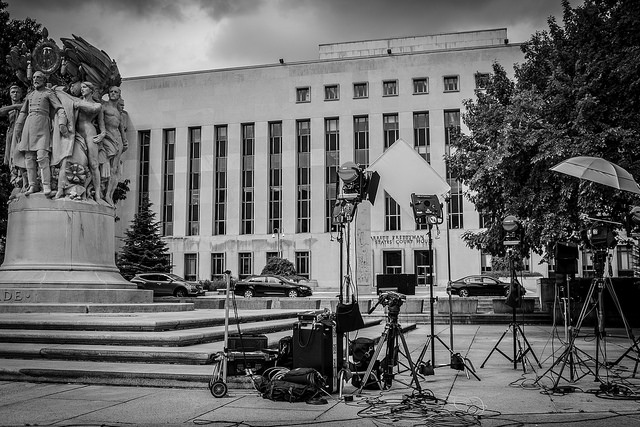What to Make of the Mystery Judgment in In re Grand Jury Subpoena
Earlier this evening, Dec. 18, the U.S. Court of Appeals for the D.C. Circuit released a judgment in In re Grand Jury Subpoena, a mysterious case that has drawn attention for its suspected connection to the Mueller investigation. The ostentatious secrecy has fueled speculation that the case might involve something as dramatic as an effort to secure testimony from the president himself.

Published by The Lawfare Institute
in Cooperation With

Earlier this evening, Dec. 18, the U.S. Court of Appeals for the D.C. Circuit released a judgment in In re Grand Jury Subpoena, a mysterious case that has drawn attention for its suspected connection to the Mueller investigation. The ostentatious secrecy has fueled speculation that the case might involve something as dramatic as an effort to secure testimony from the president himself. It turns out that that’s not true—but the appeals court’s decision does set out some hints about what might be going on.
The case first caught the attention of the press when Politico reporter Darren Samuelsohn overheard an unknown man request the latest sealed filing from the special counsel’s office—and noticed a sealed response appear in a grand jury case three hours later. Speculation heated up when former prosecutor Nelson Cunningham suggested that the Mueller link and the unusually speedy handling of the case might indicate a battle over a presidential subpoena. Oral arguments before the D.C. Circuit on Dec. 14 only added to the mystery: The federal courthouse closed off an entire floor to keep journalists from picking up any clues as to the identity of the litigants. CNN spotted two members of Robert Mueller’s team, Zainab Ahmad and Michael Dreeben, arrive back at the special counsel’s offices 10 minutes after arguments concluded.
So the court’s ruling in In re Grand Jury Subpoena is effectively the first peek at a very secret case. The court outlines the contours of the case in the judgment’s first paragraph: The appellant is a corporate entity (“the Corporation”) that is owned by a foreign country (“Country A”) and is seeking to quash a subpoena it received from a grand jury in an undisclosed criminal matter. The Corporation made two arguments in support of this effort before the district court: first, that it is entitled to sovereign immunity; and, second, that complying would place it in violation of Country A’s own laws. The district court rejected both arguments and—when the Corporation still refused to comply—held the Corporation in contempt, imposing a fixed monetary penalty on it so long as it refuses to comply. The Corporation then appealed to the D.C. Circuit, where it also argued that the district court lacked subject-matter jurisdiction over the issue. In Tuesday’s judgment, the D.C. Circuit rejects all three arguments and affirms the district court’s decision.
What more does the judgment say about the identity of Country A? Only a bit. The court asserts that “there is no question” that the Corporation falls within the definition of a “foreign state” under the Foreign Sovereign Immunities Act (FSIA) for the purposes of sovereign immunity. It specifically cites 28 U.S.C. § 1603(b)(2), which addresses agencies and instrumentalities of foreign states and includes within that definition corporations that are majority-owned by foreign sovereigns. This almost certainly means that the Corporation is majority-owned by Country A, an inference with which the Corporation’s own arguments are consistent: As the court describes them, the Corporation’s argument would “completely insulate corporations majority owned by foreign governments from all criminal liability.” And under relevant case law, this ownership is almost certain to be direct, not through subsidiaries or other arrangements.
Unclear, however, is to what extent Country A’s ownership of the Corporation means that it is actively involved in fighting the subpoena. As the court’s judgment describes, the Corporation produced “submissions from . . . a regulator from Country A” in support of its interpretation of Country A’s laws—but only after initially relying solely on “submissions from the Corporation’s own counsel.” In rejecting this submission as inadequate, the court cites “the role and authority of the entity or official offering the statement” as a relevant factor. This may reflect doubts on the part of the court as to whether the regulator has the authority to speak authoritatively on behalf of Country A, particularly as relevant case law urges that “a government’s expressed view of its own law is ordinarily entitled to substantial but not conclusive weight.” The Corporation’s inability to produce a more authoritative statement from Country A officials in a timely manner may in turn reflect a limited willingness on Country A’s part to intervene on the Corporation's behalf, at least at this juncture.
Finally, the judgment may give some tiny hints about the Corporation’s activities. In concluding that the Corporation falls within the FSIA’s commercial-activity exception to sovereign immunity, the court—quoting the FSIA—notes that the government has shown that there is a reasonable probability that “the action underlying the motion relates to “an act outside the territory of the United States in connection with a commercial activity of the foreign state elsewhere” with “a direct effect in the United States.” This appears to mean that the testimony or documents that the grand jury is interested in relate to some overseas commercial activity of the Corporation, not acts or activities within the United States.
What does this tell us about the Corporation and its involvement in L’Affaire Russe? This judgment is certain to produce a great deal of speculation, but there is simply too little information to draw any firm conclusions. Indeed, given the proliferation of state-owned entities in several countries at the center of L’Affaire, it is not even clear whether the Corporation is a familiar character in the story so far or a new player altogether. As with every step of the Russia investigation so far, there is a lot that remains in the shadows.




.jpg?sfvrsn=676ddf0d_7)

